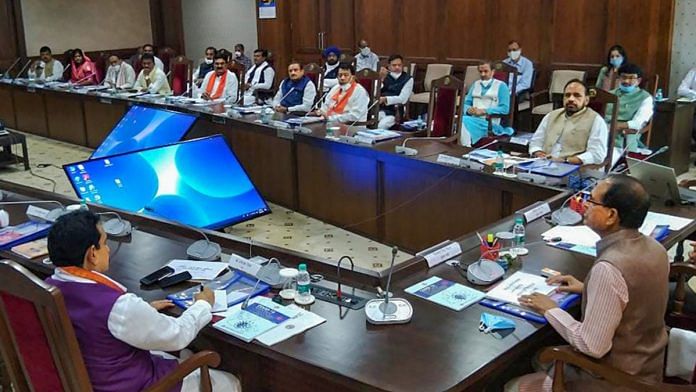New Delhi: The newly-formed Madhya Pradesh cabinet signals the ‘Congressisation’ of the BJP, ThePrint’s editor-in-chief Shekhar Gupta said in episode 512 of Cut The Clutter.
An analysis of the cabinet, and where the loyalty of its members lie, shows that MP Chief Minister Shivraj Singh Chouhan has been cut to size. In fact, he has been rendered a lame duck who’s also been kneecapped.
Fourteen of the 33 cabinet members are former Congress leader Jyotiraditya Scindia’s loyalists; they had defected to the BJP with Scindia back in March. This means more than 40 per cent of the people, who aren’t even members of the House yet, have been made ministers.
Three others are loyalists of BJP’s Narottam Mishra while three are loyalists of the party’s national general secretary Kailash Vijayvargiya. This leaves just 13 ministers who are actually CM Chouhan’s loyalists, which means he has very little space to do or say anything.
But it isn’t just Madhya Pradesh which is showing these signs. Of the 17-NDA ruled states, BJP has its chief ministers in 12, but a closer look reveals a slow move towards a complete ‘Congressisation’ of the BJP.
For one, this indicates the rise of a high-command culture in the BJP, just like that of the Congress. Only one person or a couple of people own that high command space — similar to how the Congress is presently run by just a few people, such as Rahul Gandhi and Sonia Gandhi.
This also shows that the BJP now has very weak CMs as well as cabinet ministers. This is because all the power within the party emanates from one source.
BJP’s once formidable CMs brigade
One of the main reasons why Prime Minister Narendra Modi came to power with such a resounding mandate in 2014 was due to the fact that the BJP had built very strong Chief Ministers who could always swing elections in their states for him. But six of these strong CMs are nowhere to be seen now.
Former Rajasthan CM Vasundra Raje is out of power as is former Chhattisgarh CM Raman Singh.
Gujarat had Narendra Modi as its powerful vote-catching CM, but his shift to Delhi moved that power with him. In Maharashtra, Nitin Gadkari, who could swing elections single-handedly, has now been sidelined.
In Madhya Pradesh, Chouhan has also been sidelined, cut to size and rendered powerless despite being the CM.
On Wednesday, at the swearing-in ceremony, he cryptically commented that “amrit (nectar of immortality) comes out of the churning of the ocean as Shiva consumes vish (poison)”, in what may be a metaphorical reference to himself.
Trend catching on
Other BJP-ruled states signal a similar trend. The formula of keeping your chief minister reduced to a nobody who gets instructions from Delhi for anything he wants to do is being repeated in all the states.
For instance, Assam’s CM Sarbananda Sonowal is seen to have very little power. In fact, it is the Health Minister Himanta Biswa Sarma who is considered the face of the Assam government. He is also seen as the face of the BJP in all of the Northeast. He won the Northeast for the BJP.
In Haryana, Manohar Lal Khattar has had to share power with his deputy and JJP leader Dushyant Singh Chuatala, after the two parties were forced to form a coalition government. Cabinet minister Anil Vij too occupies a very important, powerful position in the state government.
In Gujarat, CM Vijay Rupani is remote-controlled from New Delhi, which is a well-known fact.
Manipur CM Biren Singh was forced to restore the portfolios of his deputy CM, National People’s Party leader Y. Joykumar Singh, as part of the understanding reached between Union Home Minister Amit Shah and the NPP delegation led by its national president and CM of neighbouring Meghalaya, Conrad Sangma.
This means that while Singh may be the CM, the real authority and power lies with the high command in Delhi.
In Karnataka, B.S. Yediyurappa’s authority has been undermined time and again, most recently when none of his Rajya Sabha nominees were selected by the party high command, which instead backed those of Yediyurappa’s rival, B.L. Santosh.
The one exception to this rule is Uttar Pradesh CM Yogi Adityanath. He was seen as a political lightweight with no real following of his own. But the fact is that the way Adityanath has conducted himself has not only made him more of a Hindutva brand ambassador but also a brand ambassador for Modi and Shah. He wasn’t chosen to be an exception, but just turned out to be one.
Watch the full episode here:



